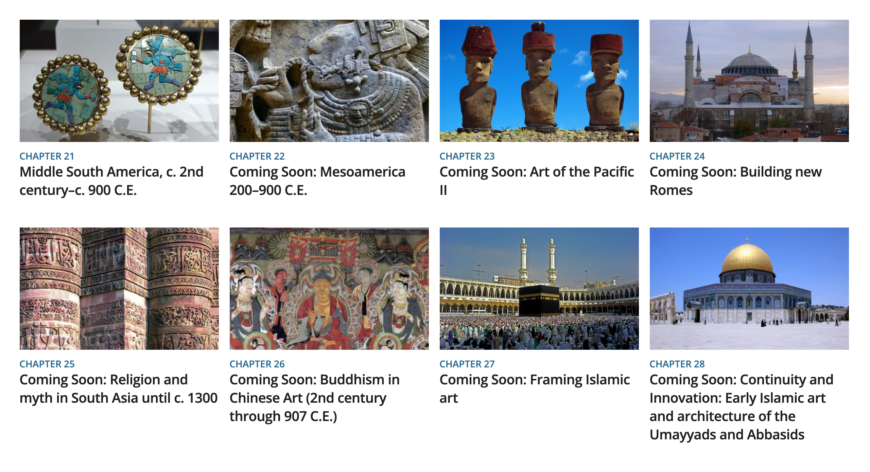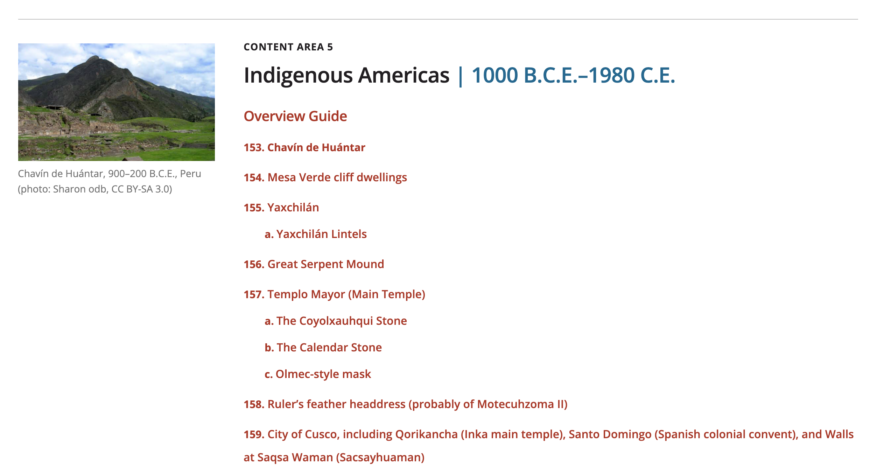How Reframing Art History developed
Hello to all who are interested in learning more about Reframing Art History! I am Lauren Kilroy-Ewbank, the general editor for this project and the Dean of Content and Strategy at Smarthistory. I thought I’d take a moment to share with you how this “textbook” developed and what you can find (or not find) in it. I hope you are as excited about it as I am.
How did we get here?
The idea behind Reframing Art History developed over many years. It is the result of my own successful and failed experiments in teaching, many conversations with students and colleagues about art history, research and writing about how to teach, and my work with Smarthistory and the many conversations I’ve had with Beth Harris and Steven Zucker (the co-founders and Executive Directors of Smarthistory) over the years.
More than a decade ago, I found myself teaching a year-long “Western Art” survey to hundreds of students, only to be followed not long afterward by a one-semester world art survey (everything in the history of the world!) to only 25 students. Both types of survey courses posed unique challenges—from what to cover and what not to cover, how to help students grasp big ideas, and how to balance breadth and depth. I did not find existing textbooks helped much. Besides being too expensive, they both covered too much and not enough all at once. I admit that I found textbooks baffling, which was no doubt informed by my own background as someone who specialized in the art of Latin America prior to 1800—art that rarely made it into art history survey textbooks, and when it did, only in the most cursory way.
In my classes, I wanted to craft readings for my students that reflected the material I thought would be important and interesting to them as well as what they told me they wanted to learn more about. I also felt strongly that materials be low cost or free, and so began my journey to find accessible, high-quality, free materials online. (I even wrote an idealistic manifesto about a need to develop a free world art history survey written by many experts at one point!) Ultimately, this journey led me to Smarthistory, and what a rich resource and collaborative community it turned out to be.
Many years and conversations later, the stage was set for the development of such a massive project—a free, world art history textbook that could reframe deeply embedded narratives in art history, all developed with a large group of experts who had different ideas about what would make for compelling stories to share with students. Smarthistory already had experience with these types of projects on a smaller scale—Seeing America, Expanding the Renaissance, and the At-Risk Cultural Heritage Education Series (ARCHES). We’ve worked with about 500 art historians, curators, archaeologists, and more, which meant that Reframing Art History would be inherently collaborative, and not the result of just a handful of voices steering the narrative. For instance, this first round of 40 collaborators that I invited to develop chapters worked more like curators: they were asked to select no more than 20 essays and videos that existed on Smarthistory—which currently has about 4,000 videos and essays—and to craft a compelling story about a specific place in time or a theme that could frame objects, buildings, and sites in new ways. The idea was to also offer a more balanced account of world arts, one that doesn’t overwhelmingly privilege specific places, time periods, and peoples. Where possible, I encouraged collaborators to consider issues of networks (such as trade), cultural entanglements, racial and gender ideologies, science and new technologies, materiality, experimentation, propaganda, intolerance, resiliency, and even environmental and ecological concerns. It has been a remarkably exciting journey from conception and development to production and publication.
What is in Reframing Art History . . . and what is not
79 chapters (so far!) about a broad range of world art
To create Reframing, I knew I wanted to work with a large group of scholars who valued teaching, public art history, and the idea of reframing traditional art history narratives. This amazing initial group of collaborators, all of whom are listed at the bottom of the Reframing Art History landing page, worked hard to think of 79 chapters for the first iteration of the textbook. The chapters range from the earliest art of South Asia and art under the Mongols to art in Italian Renaissance republics and Latin American modernisms. In conversations with many of my collaborators I’d often hear statements like “this subject is where my students get tripped up” and “this really resonates with my students”—both statements turned out to be helpful for collaborators to consider as their chapters formed. We always kept our students in mind. But we didn’t just think of our own students—we tried to think creatively about other opportunities before us. Reframing has the potential to reach millions of people around the world, to offer readers of all ages engaging materials that presume no prior knowledge, and to do something different than books in print. (As an aside, this is not to say that there is not value in printed books—they just do different things; online and printed materials each have their own strengths.)
Because this is a born-digital textbook, Reframing can easily be updated and improved as new materials are developed. It means that we can be iterative, which is how we normally work at Smarthistory. As new essays and videos appear on Smarthistory, authors can alter their chapters. As new scholarship is published, authors can update chapters to reflect important conversations in the field of art history. These are valuable strengths of this textbook.
Three major iterations
Reframing Art History has been planned with three major iterations in mind.
- January–August 2022: c. 60 chapters will be published as the first iteration is completed. (As I write this on our official launch day on January 26, 2022, this is everything you see on the Reframing Art History home page, including what is noted as “coming soon.”)
- Winter/Spring 2023 and Winter/Spring 2024: The second and third iterations will appear in the next year and beyond. This means more chapters to flesh out certain areas, as well as teaching and learning resources incorporated into the project to help educators brainstorm how they might use some of these materials. This also means even more collaborators.
If you’d like to learn about some ways you can use the textbook, please read this separate page.
AP Art History materials
Clear to me from the outset was my desire to incorporate the AP Art History list of 250 objects/sites into Reframing‘s chapters. While Smarthistory already has an entire section devoted just to the AP Art History curriculum, Reframing seemed a wonderful opportunity to place the items on that list into broader conversations about art. Eventually, the entire AP Art History list will be included in Reframing Art History.
Where Reframing will continue to grow
And while I am absolutely thrilled with how far we’ve come, there is more work to be done. As you peruse Reframing Art History, you will notice that there are places and peoples at different moments in time that are not yet represented in this textbook. Where are chapters focused on Korean or later Islamic art, for instance? What about all of Southeast Asia? The answer is simple: currently, we don’t have enough essays and videos (yet!) to support a chapter or multiple chapters that do justice to some material. As always, we are committed to growing areas, but it does take time to do it responsibly and well and also requires more funding (we are a not-for-profit). Our hope is that over the next couple of years we can continue to work with collaborators to build essays and videos so that we have the ability to develop amazing chapters to add to Reframing—which is to say, stay tuned! If you would like to help grow this amazing resource and community, please don’t hesitate to reach out to me, Beth, and Steven.
Support for this book
Reframing Art History has been generously supported with funds and donations from the Andrew W. Mellon Foundation and the Kress Foundation, among others. I am so grateful for their support of this project. Thank you so much.
This book would also have been impossible to produce without the hundreds of scholars who have offered their expertise and time to write essays, record audios for videos, and develop chapters, among other things. My heartfelt thanks goes out to all of them. And many thanks also to my students over the years who have challenged me in all the best ways to think about art history differently.
I’d be remiss not to thank my amazing Smarthistory colleagues—Beth Harris, Steven Zucker, Kayla McCarthy, Julia Campbell, Evan Freeman, Kimberly Kutz Elliott, and Margo—for their support, help, guidance, and humor. Reframing would not exist without them. My newest colleagues—Sarah Alvarez and Ariel Fein—have just joined Smarthistory at the time this textbook goes live, but I’ve no doubt that we will put our heads together about future directions of Reframing Art History. We all make a great team.



